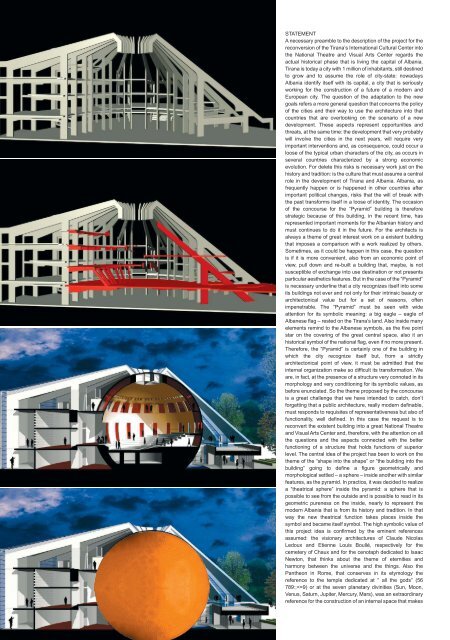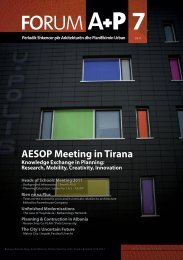Forum A+P 08
POLIS University publishes the “Forum A+P” journal, the only scientific and cultural magazine in the Albanian –speaking countries for the fields of architecture and territory planning. This magazine is recognized by the Ministry of Education and Science, the Academic Degrees Evaluation Committee and has an ISSN international registration code in France. The magazine is published in Albanian and English language and contains a package of scientific, informative articles and analysis.
POLIS University publishes the “Forum A+P” journal, the only scientific and cultural magazine in the Albanian –speaking countries for the fields of architecture and territory planning. This magazine is recognized by the Ministry of Education and Science, the Academic Degrees Evaluation Committee and has an ISSN international registration code in France. The magazine is published in Albanian and English language and contains a package of scientific, informative articles and analysis.
- No tags were found...
You also want an ePaper? Increase the reach of your titles
YUMPU automatically turns print PDFs into web optimized ePapers that Google loves.
68<br />
STATEMENT<br />
A necessary preamble to the description of the project for the<br />
reconversion of the Tirana’s International Cultural Center into<br />
the National Theatre and Visual Arts Center regards the<br />
actual historical phase that is living the capital of Albania.<br />
Tirana is today a city with 1 million of inhabitants, still destined<br />
to grow and to assume the role of city-state: nowadays<br />
Albania identify itself with its capital, a city that is seriously<br />
working for the construction of a future of a modern and<br />
European city. The question of the adaptation to the new<br />
goals refers a more general question that concerns the policy<br />
of the cities and their way to use the architecture into that<br />
countries that are overlooking on the scenario of a new<br />
development. These aspects represent opportunities and<br />
threats, at the same time: the development that very probably<br />
will involve the cities in the next years, will require very<br />
important interventions and, as consequence, could occur a<br />
loose of the typical urban characters of the city, as occurs in<br />
several countries characterized by a strong economic<br />
evolution. For delete this risks is necessary work just on the<br />
history and tradition: is the culture that must assume a central<br />
role in the development of Tirana and Albania. Albania, as<br />
frequently happen or is happened in other countries after<br />
important political changes, risks that the will of break with<br />
the past transforms itself in a loose of identity. The occasion<br />
of the concourse for the “Pyramid” building is therefore<br />
strategic because of this building, in the recent time, has<br />
represented important moments for the Albanian history and<br />
must continues to do it in the future. For the architects is<br />
always a theme of great interest work on a existent building<br />
that imposes a comparison with a work realized by others.<br />
Sometimes, as it could be happen in this case, the question<br />
is if it is more convenient, also from an economic point of<br />
view, pull down and re-built a building that, maybe, is not<br />
susceptible of exchange into use destination or not presents<br />
particular aesthetics features. But in the case of the “Pyramid”<br />
is necessary underline that a city recognizes itself into some<br />
its buildings not ever and not only for their intrinsic beauty or<br />
architectonical value but for a set of reasons, often<br />
impenetrable. The “Pyramid” must be seen with wide<br />
attention for its symbolic meaning: a big eagle – eagle of<br />
Albanese lag – rested on the Tirana’s land. Also inside many<br />
elements remind to the Albanese symbols, as the ive point<br />
star on the covering of the great central space, also it an<br />
historical symbol of the national lag, even if no more present.<br />
Therefore, the “Pyramid” is certainly one of the building in<br />
which the city recognize itself but, from a strictly<br />
architectonical point of view, it must be admitted that the<br />
internal organization make so dificult its transformation. We<br />
are, in fact, at the presence of a structure very connoted in its<br />
morphology and very conditioning for its symbolic values, as<br />
before enunciated. So the theme proposed by the concourse<br />
is a great challenge that we have intended to catch, don’t<br />
forgetting that a public architecture, really modern deinable,<br />
must responds to requisites of representativeness but also of<br />
functionality, well deined. In this case the request is to<br />
reconvert the existent building into a great National Theatre<br />
and Visual Arts Center and, therefore, with the attention on all<br />
the questions and the aspects connected with the better<br />
functioning of a structure that holds functions of superior<br />
level. The central idea of the project has been to work on the<br />
theme of the “shape into the shape” or “the building into the<br />
building” going to deine a igure geometrically and<br />
morphological settled – a sphere – inside another with similar<br />
features, as the pyramid. In practice, it was decided to realize<br />
a “theatrical sphere” inside the pyramid: a sphere that is<br />
possible to see from the outside and is possible to read in its<br />
geometric pureness on the inside, nearly to represent the<br />
modern Albania that is from its history and tradition. In that<br />
way the new theatrical function takes places inside the<br />
symbol and became itself symbol. The high symbolic value of<br />
this project idea is conirmed by the eminent references<br />
assumed: the visionary architectures of Claude Nicolas<br />
Ledoux and Etienne Louis Boullé, respectively for the<br />
cemetery of Chaux and for the cenotaph dedicated to Isaac<br />
Newton, that thinks about the theme of eternities and<br />
harmony between the universe and the things. Also the<br />
Pantheon in Rome, that conserves in its etymology the<br />
reference to the temple dedicated at “ all the gods” (56<br />
789:;





